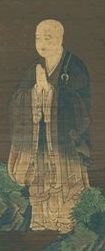Koso Wasan 62
Manifested from the oceanlike great mind
Was Master Shan-tao;
For the sake of beings of this defiled world in the latter age,
He called on the Buddhas of the ten quarters to bear witness
to his teaching.
Master Shan-tao

We are now about to embark on the verses that comprise the pinnacle of Shinran Shonin's cycle of verses.
The Koso Wasan (Hymns of the Pure Land Masters) collection represents the key points of his doctrine. But the section of the wasan dedicated to Shan-tao (613 - 681) is the heart of all of the wasan. It deals with every element of Pure Land teaching: every salient point of Shinran Shonin's doctrine. We discover, in full, the nature of shinjin, contemplate the allegory of the Two Rivers and a White Path, deepen our understanding of the relative merits of practice within Pure Land tradition - all with a depth and intensity that is unmatched in other sections of the Wasan. Indeed, I have always felt that these verses could very well stand alone. On reading - or reflecting - upon them, we are left with a sense of completeness.
It is impossible to exaggerate the significance of Master Shan-tao in the life of the Pure Land tradition. Few would doubt his eminence and the immense importance of his achievements. His most important endeavour was the production of a large, four fascicle Commentary on the Contemplation Sutra. This work set out ideas which were to become characteristic of Pure Land teaching and also confirmed his predecessors, T'an-luan and Tao-ch'o, as the seminal thinkers of the school. In addition, Shan-tao set in train a wonderful liturgical tradition which was to become a characteristic of Pure Land Buddhism until the time of Rennyo Shonin, a descendant of Shinran, who lived in the fifteenth century. Rennyo replaced Shan-tao's liturgy with the writings of Shinran Shonin - providing forms which were more accessible to ordinary people. However, the Honpa- Hongwanji still uses parts of Shan-tao's liturgy on special occasions
Shan-tao was always a monk. It is said that he observed the rules of the vinaya scrupulously. He began his life in the monastery at a very early age and dedicated himself to the study of the Lotus Sutra and the Vimilakirti Sutra. The light that shone from Shan-tao in his monastic home in Ch'ang-an is in stark contrast to the deep darkness that encompassed much of the world; especially the Middle East and Europe, which was convulsed with an even higher level of violence and destruction than usual. When he met Tao-ch'o, Shan-tao became his disciple and actually succeeded in the Pratyutpanna Samadhi1 - seeing at first hand Amida Buddha and his Pure Land.
Shan-tao stands, as it were, at the centre of the Pure Land way. He lived at a half-way point between the time of Shakyamuni and the present. I also see him as the focal point of the Pure Land tradition because every school acknowledges him as a master of the way - he is one of the common factors in all Pure Land discourse.
Drawing on earlier resources Shan-tao is the midwife of the Pure Land movement, bringing a school that had been conceived in the teaching of Shakyamuni - and underwent gestation for more than a millenium - to the fullness of its term and its final emergence into the light of day as a school in its own right, complete and well-formed.
As we consider each one of Shinran's verses on Shan-tao we will have ample opportunity to reflect upon the details of his teaching. For the moment, however, we do well to remember that it was Shan-tao who formed the insights of his predecessors into a coherent system, which discredited the traditional assumption that the Pure Land way was somehow only partially effective and qualified by limitations. Two of these were: the habit of seeing the Pure Land as a distant goal, which was not necessarily attained upon our next birth; and that Amida Buddha was a nirmanakaya Buddha because he was accessible to those who were of inadequate capacity. These ideas tended to weaken the value of the Pure Land way as a vehicle of liberation from samsara.
Shan-tao's certainty of the veracity and efficacy of the Pure Land way is obviously drawn from his personal experience of Amida Buddha during the successful accomplishment of the pratyutpanna samadhi that I have already mentioned. This imbued Shan-tao with an intimate consciousness of Amida Buddha that resulted in a certainty, which transcends the limitation of language, culture and time - and reaches across these barriers to find a home in the listening heart of those who turn to him for guidance, even now.
We can rest assured that when we sit at the feet of Shan-tao, we are sitting in the teaching-hall of Amida Buddha himself. All seekers within the Pure Land tradition have seen Shan-tao as the embodiment of the 'sea of great Compassion' - an allusion to Amida Buddha.
1: Pratyutpanna Samadhi Sutra - Sutra of the samadhi of being in the presence of all Buddhas.